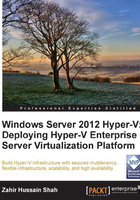
Hyper-V Virtual Machine Management Service
Virtual Machine Management Service is the management engine of Hyper-V. Virtual Machine Management Service (VMM Service or VMMS) is responsible for the management of the virtual machine state for the child partitions. This includes making the right decision to change the virtual machine state, handling the creation of snapshots, and managing the addition or removal of devices. When a virtual machine in a child partition is started, the VMMS spawns a new VM worker process, which is used to perform the management tasks for that virtual machine.
Virtual devices
Virtual devices (vDevices) are the application interfaces that provide control over devices to the VMs. There are two types of vDevices, as follows:
- Core devices
- Emulated devices
- Synthetic devices
- Plugin devices
Let's see the difference between these devices.
These virtual devices emulate a specific hardware device, such as a VESA video card. Most core vDevices are emulated devices like this, and examples include BIOS, DMA, APIC, ISA bus, PCI bus, PIC device, PIT device, Power Management device, RTC device, Serial controller, Speaker device, 8042 PS/2 keyboard/mouse controller, Emulated Ethernet (DEC/Intel 21140), Floppy controller, IDE controller, and VGA/VESA video. Another aspect of the emulated devices is that they run in the user mode of the TCB concept and have less ability to interact with the server hardware.
These virtual devices do not model specific hardware devices. Examples of synthetic devices include a synthetic video controller, synthetic human interface device (HID) controller, synthetic network interface card (NIC), synthetic storage device, synthetic interrupt controller, and memory service routines. These synthetic devices are available only to guest operating systems that support Integration Services.
As we saw previously, emulated devices run in Ring 3 (which is a user ring) and therefore cannot directly interact with the hardware resources; they thus have limited reliability and approachability. On the other hand, synthetic devices run under the kernel mode, which allows them to run faster and be more reliable.
Plugin devices are different from other types of devices. These devices allow direct communications between the parent and the child partition. These devices can safely be removed and added whenever it is necessary. Examples of these types of devices are human interfaces and mass storage devices.
The virtual machine bus is the communication medium between the parent partition (hypervisor) and the child partition (VM). VMBus is the backbone of the overall management and data transmission from parent to child, and vice versa. All the instructions go from the parent partition to the child partition via VMBus. If the VM needs to access the DVD-ROM on the hypervisor server, this request from the child partition (VM) to the DVD-ROM will go through VMBus.